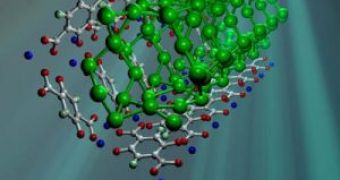How do you make hydrogen more solid than a solid? It doesn't make any sense! It might not make sense to us, however researchers from the National Institute of Standard and Technology's Center for Neutron Research could have found the answer in what they call metal-organic frameworks, or MOFs for short. They believe that by using MOFs they can create hydrogen storing tanks with higher capacity, lower storing pressures, and higher temperatures than any other class of hydrogen fuel tank previously developed.
The metal-organic framework materials are part of the class of materials which can combine with hydrogen in special conditions, and release the gas when needed without the disadvantages posed by all the other previous materials, which require for example temperatures as high as 500 degrees Celsius to break the bond between them and hydrogen.
The material developed by NIST in collaboration with the University of Maryland and California Institute of Technology, dubbed MOF-74, is a substance similar to a porous crystalline powder, created out of carbon atoms and zinc ion columns. Because of its high surface area, it is able to absorb and contain more hydrogen gas into a smaller volume. For example, a single gram of MOF-74 has the same surface area as a flat surface equivalent to two basketball pitches.
"When we started doing experiments, we realized the metal interaction doesn't just increase the temperature at which hydrogen can be stored, but it also increases the density above that in solid hydrogen. This is absolutely the first time this has been encountered without having to use pressure," said NCNR researcher Craig Brown. Brown reveals that the team doesn't yet understand what causes this interaction between hydrogen and MOF-74.
The material still has many disadvantages, such as requiring liquid-nitrogen temperatures while bonding with hydrogen, however at least hydrogen is turned solid without bringing it to a temperature of -269 degrees Celsius - the temperature of solid hydrogen. Brown says that MOF-74 helped scientists better understand energy density, but there are still many other factors which must be studied before attempting an increase in storing temperature. One day, it may even allow us to store hydrogen fuel in a solid form without the need of refrigerating systems or insulation.

 14 DAY TRIAL //
14 DAY TRIAL //